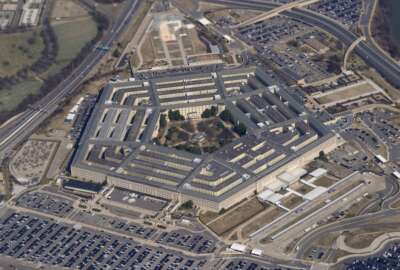DoD’s effort to broaden cyber workforce kicking into gear
Matthew Isnor, who leads cyber workforce development in DoD’s CIO’s office, said a new policy expands the number of job categories in the cyber workforce.
Of all the focus areas of the Defense Department’s new Office of the Assistant Secretary of Defense for Cyber Policy, the development and retention of the workforce may be its toughest, and most important.
The Pentagon, which established the new cyber office at the end of March, is trying to cut its cyber workforce vacancy rate by 25% by 2025.
Matthew Isnor, the branch chief for the cyber workforce development in the DoD’s chief information officer’s office, said to reach that cyber workforce goal, DoD will lean on its new 8140 policy to reimagine how it trains and recruits cyber workers.
“One of the big fact findings that we had over the last decade is the traditional pathways was go get your four-year degree education in cyber. But the talent out there has different traditional pathways. They get certifications. They get education. They get training and other ways as a lot of our military individuals come up and don’t have any of that. So there’s a lot of ways that we need to be able to kind of attract the right talent coming in. We need to think outside the box,” Isnor said in an interview with Federal News Network at the West 2024 conference sponsored by AFCEA and the U.S. Naval Institute. “We need to be able to attract the individuals that just love building networks, that sit down in their mom’s basement and sit there and start coding a lot of these things. Because that’s the true cyber person in the environment there that we need. We need to be able to identify ways that we can get them in into our jobs, and bring that expert talent into DoD.”
DoD CIO John Sherman signed the DoD 8140 in February 2023, issued the DoD Cyber Workforce Strategy in March and released the cybersecurity workforce implementation plan in July. All of these foundational documents are setting the military services and defense agencies up with tools, processes and procedures to hire experts, who admittedly are in short supply everywhere.
The 8140 policy, released in February 2023, replaced the 8570 policy series, which focus most mostly on the information assurance workforce.
DoD searching for biggest talent pool
Isnor said the 8140 policy, which DoD developed over about a six-year period, expands the scope to include everything from cyber operations to artificial intelligence, data, software engineering and many other job categories.
“We wanted to expand the scope, the aperture to be able to qualify the workforce. We want to make sure that they’re ultimately being capable of doing the job that we’re allowing them to do,” he said. “So 8140 really focuses on qualifying the individuals in the environment that we’re bringing them into ultimately be able to do. 8140 is touching the bigger talent pool. The individuals coming up from this environment, I like to use a tree analogy, has a lot of STEM background there so the trunk they’re bringing up their knowledge base, and then they specialize into various fields, cybersecurity, IT, AI or data, and we will need to be able to work as a department so we don’t fight over the same talent. We need to be working together to codify what that looks like.”
Over the next few years as the military services and defense agencies implement 8140, Isnor said the DoD CIO’s office will provide them with tools track their progress with identifying and training the workforce.
He said the cyber workforce strategy and 8140 set a goal of February 2026 for the services and agencies to begin tracking seven elements.
Working with DoD academic partners
“The first one will be any of the billets that are coded against the cybersecurity work roles will ultimately be reporting on 8140 and their qualifications,” Isnor said. “Then, we’ll start working through that to find the lessons learned about how the tracking is going, how that aligns and then the rest of the workforce. Ultimately, in any of the elements will start tracking in February 2026.”
At the same time, DoD CIO’s office is working with academic institutions, including the CIA’s Centers of Academic Excellence, which includes about 450 different universities. The National Defense University runs a cyber consortium, where it brings in a lot of think tank individuals to help teach its students.
“We have the current workforce with the DCWF where we have 72 work roles inside of that. We identify what are critical needs for workers, and what we want our workforce to look like,” he said. “But then we also get into the areas of what is the emerging technology? What are the areas of the future that ultimately might start creeping into the frameworks into the areas of the workforce? Quantum obviously. Hypersonics is one of the areas so we start trying to game plan for that the next couple of decades of where we’re going to go in technology.”
In addition to its employees and service members, DoD’s contractor workforce also must adhere to the requirements under 8140.
Isnor said DoD contracting officers must start adding new clauses into contracts requiring the vendors meet the workforce mandates.
“The biggest challenge is getting out in front and understanding what the capabilities of our workforce are. There’s a lot of cyber individuals inside of educational programs that are out there doing that. They are in high schools that are doing cyber, and I don’t think are necessarily aware of what all the cool jobs that the federal government,” he said. “From the department’s perspective, we need to get more proactive in going out and recruiting, and coming up with programs to incentivize them to come to DoD, instead of going to various industry partners.”
Copyright © 2025 Federal News Network. All rights reserved. This website is not intended for users located within the European Economic Area.
Jason Miller is executive editor of Federal News Network and directs news coverage on the people, policy and programs of the federal government.
Follow @jmillerWFED






